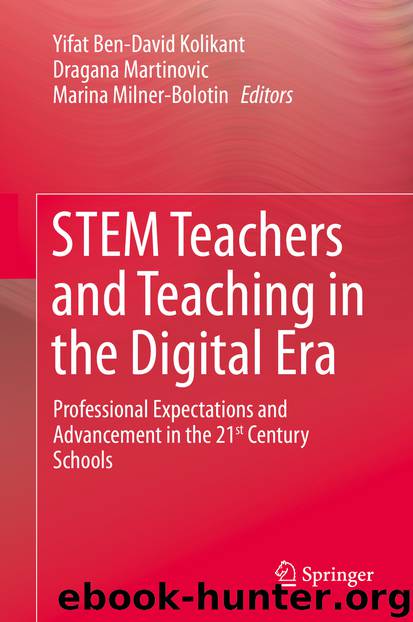STEM Teachers and Teaching in the Digital Era by Yifat Ben-David Kolikant & Dragana Martinovic & Marina Milner-Bolotin

Author:Yifat Ben-David Kolikant & Dragana Martinovic & Marina Milner-Bolotin
Language: eng
Format: epub
ISBN: 9783030293963
Publisher: Springer International Publishing
In all the workshops, as part of the adjustments, CK was added. For example, Shulamit (WS1) describes herself as being “shocked. Some here do not know how to program”. Therefore, “after the first meeting, I developed a [PowerPoint] presentation that included contents that are supposed to be taught before this new unit and I also summarized the chapters.” The LTs discussed what to teach given the heterogeneity on the one hand and the fear to insult the teachers on the other hand: “we hesitated whether we should bring the basic contents. After all, they are teachers. They have background” (Orna, WS1, in the CS-LTC).
The LTs had different expectations from the teachers in their workshops and different approaches to teaching them. In fact, there was a spectrum of perceptions of the teachers. On one pole were WS3 and WS2, where teachers were perceived as experienced teachers. This brought about the decision to build on their acquaintance with the CK and their PCK in CS. This is demonstrated in the frequent openings of new topics with phrases such as: “I assume that you know this topic so I am not going to teach it, only present it” and “this topic is known, concepts are the same, ‘a node is a node’.” In W2, the teachers were asked to produce deliverables that the LTs themselves had produced during the CS-LTC, such as exercises, examples, and lab assignments. Finally, in WS2 and WS3, teachers were also exposed to deeper, conceptually-oriented pedagogical considerations, such as the order of teaching the topics, as was done in the CS-LTC itself.
The LTs perceived the difficulties that the workshop participants experienced as natural, due to the need to learn and comprehend the new program, just as the LTs themselves experienced when they first had studied OOP: “I see me [in them] two years ago. This struggle, standing on the rear feet, not seeing the big picture, struggling with the little bits and not seeing the beauty of the essence of the change” (Adi, WS2).
On the opposite end of the spectrum was WS1. There teachers were perceived as students. In this workshop much time was devoted to teaching the CK, the time devoted to pedagogical considerations was rather low in comparison to W2 and W3. WS1 focused almost exclusively on immediate relevance and there were almost no thought-provoking questions regarding CK and PCK .
Download
This site does not store any files on its server. We only index and link to content provided by other sites. Please contact the content providers to delete copyright contents if any and email us, we'll remove relevant links or contents immediately.
Spare by Prince Harry The Duke of Sussex(4997)
Navigation and Map Reading by K Andrew(4965)
Tuesdays with Morrie by Mitch Albom(4601)
Cracking the GRE Premium Edition with 6 Practice Tests, 2015 (Graduate School Test Preparation) by Princeton Review(4179)
Machine Learning at Scale with H2O by Gregory Keys | David Whiting(3974)
Never by Ken Follett(3706)
Goodbye Paradise(3666)
What It Really Takes to Get Into Ivy League and Other Highly Selective Colleges by Hughes Chuck(3644)
Harry Potter and the Prisoner of Azkaban (Book 3) by J. K. Rowling(3250)
Fairy Tale by Stephen King(3157)
Pledged by Alexandra Robbins(3101)
Kick Ass in College: Highest Rated "How to Study in College" Book | 77 Ninja Study Skills Tips and Career Strategies | Motivational for College Students: A Guerrilla Guide to College Success by Fox Gunnar(3042)
Sapiens and Homo Deus by Yuval Noah Harari(2944)
A Dictionary of Sociology by Unknown(2927)
The Social Psychology of Inequality by Unknown(2901)
Reminders of Him: A Novel by Colleen Hoover(2864)
Graduate Admissions Essays, Fourth Edition: Write Your Way into the Graduate School of Your Choice (Graduate Admissions Essays: Write Your Way Into the) by Asher Donald(2829)
Will by Will Smith(2739)
Zero to Make by David Lang(2683)
